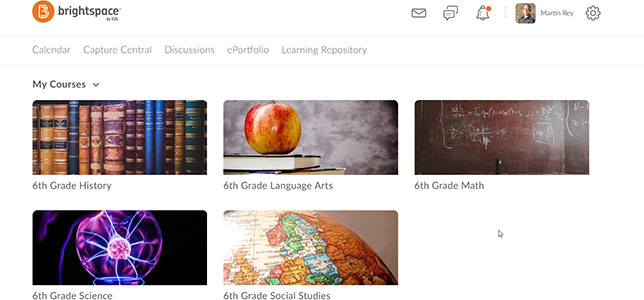K12 Deploys Brightspace Across Middle Schools and Fuel Education

A sample screen from the Brightspace LMS.
K12 is deploying D2L’s Brightspace learning management system to thousands of its middle school students across the country. K12 — one of the country’s biggest providers of online curricula and support services — already uses Brightspace LMS for thousands of its high school students.
In addition, Fuel Education — a subsidiary of K12 that features an extensive K–12 digital curriculum, as well as instructional and professional development resources — will also use Brightspace for the distribution of its curriculum. Fuel Education will begin rolling out Brightspace in December, with a full rollout scheduled for the first half of 2017.
K12 said it chose Brightspace because the LMS delivers a personalized learning experience, not the one-size-fits-all model reportedly offered by other providers. According to a news release, Brightspace was designed with modern students in mind, offering a clean, responsive user experience as well as integrated social media, game-based learning, chat and advanced video features.
The new Brightspace Daylight experience lets students and teachers use smartphones, tablets or any browser-enabled device, allowing for more mobile learning. Brightspace also offers real-time learning analytics.
“Our goal in considering a new LMS was to improve student engagement, retention and outcomes while advancing our effort to deliver a more mobile-ready curriculum,” said Lynda Cloud, executive vice president of products at K12, in a prepared statement. “After a thorough evaluation, K12 chose D2L to power K12’s next-generation online high school and middle school. The Brightspace platform has enabled us to provide students, learning coaches and teachers with an innovative, engaging and collaborative learning experience that puts tools and resources right at their fingertips.”
John Baker, CEO of D2L, said in a prepared statement: “D2L’s customers such as K12 Inc. care deeply about the educational experience and want a more personalized, engaging learning platform to help each learner learn their [sic] own way.”
To learn more about Brightspace, visit the D2L website. More about K12 and its virtual schools can be found at K12.com. And more information about Fuel Education can be found on the platform’s website.
About the Author
Richard Chang is associate editor of THE Journal. He can be reached at [email protected].